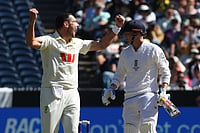INFLATION was down to 4.22 per cent for the week ending June 22. Around the same time last year, it was more than double at 9.2 per cent. So, for the householder usually left with too much month at the end of the money, it would mean prices are lower now than a year earlier, right?
Wrong. When the rate of inflation falls (rises), it merely shows that prices are now rising slower (faster). And the popular official instrument to measure this rate of change is the wholesale price index (WPI), currently stagnating around 305. Since the WPI's base year is 1981-82 (when the WPI was taken as 100), this means that prices have more than trebled over the past decade and a half. It is by holding the WPI by the neck that the Government hopes to manipulate the price line.
How? The WPI has 447 commodities under its belt, with different weights accorded to different commodity groups. Primary articles, notably food, fertilisers and items like crude oil, petroproducts, power, urea and mined coal have a total weight of almost 60 per cent. Prices of these items are fixed by the Government. In the run-up to the elections, the Rao administration chose to keep the so-called poor and middle classes happy by not raising these prices. On an average, their prices rose by only 3.5 per cent at end-December '95 compared to 10.5 per cent at end-December '94. And since they have the lion's share of the WPI, the index rose very slowly.
But does this reflect the ground realities? While foodgrains, whose wholesale prices are determined by the Government, showed only 3.3 per cent inflation compared to 13 per cent a year ago, free-priced commodities like fruits and vegetables shot up from 0.4 per cent to 17 per cent.
Real inflation rates are indicated far better at the retail price level, measured by the consumer price index (CPI), though it reflects price movements of fewer items—160 compared to the WPI's 447. Thirty essential commodities consumed by the average household have a combined weight of 48.33 in the CPI compared to 21.77 in the WPI. Since April '95, while inflation as measured by the WPI has slipped from double-digit levels to less than 5 per cent, inflation according to the CPI has hovered around 10.5 per cent on an average (see chart). Which means inflation hasn't come down at all for retail consumers!
The other way the Rao government pegged inflation at an artificial level was by keeping the money supply tight and making borrowing costly. With less money, manufacturers curtailed activity and growth plans, restricting production. Now that both these plugs have been pulled out, there are few reasons left for the WPI to behave itself.






















